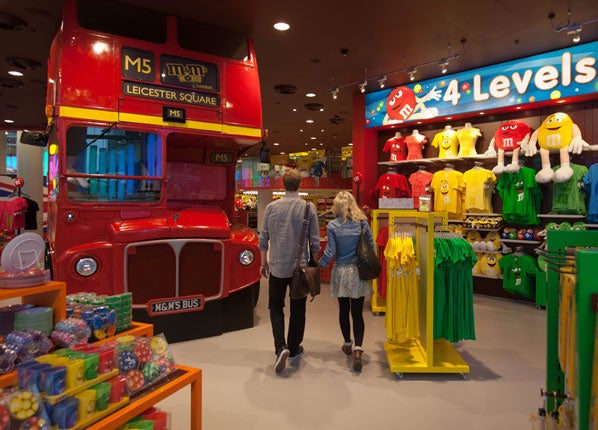As famous high-street shops fall into financial straits, could the future of physical shopping lie in high-concept 'retailtainment'? Victoria-Anne Bull finds out

A little French girl tugs at her friend's sleeve, sheer excitement pulsing through her body, her eyes gleaming. "Viens voir c'est trop rigolo!" she shouts ("Come see. It's too funny!") and drags a small boy across a blue pixie dust trail to the windows of a 28ft-tall castle.
The pair find themselves standing next to a large duck and a mouse dressed in soldiers' uniforms. The children giggle together while posing for photos with the footmen. The location of this hullabaloo is not inside the pages of a fairytale book, or even a theme park – although it could be – it is, in fact, the new Disney Store on London's Oxford Street, the largest of all of the House of Mouse's European retail branches. Opened last month, the huge shop, which spans two floors, houses animated trees and cartoons whizzing across the walls. The idea behind it is to change a dull retail shopping trip into an interactive, cheerful experience.
Customers don't have to endure messy fixtures, grey lighting and staff who are uninterested in helping you. These concept stores provide the kind of entertainment designed to make you – or at least your kids – leave the premises grinning from ear-to-ear. This is Retailtainment.
First coined by American sociologist George Ritzer in his 1999 book, Enchanting a Disenchanted World, Revolutionising The Means of Consumption, "retailtainment" was defined as "the use of sound, ambience, emotion and activity to get customers interested in the merchandise and in the mood to buy". He argued it was all about allure; the dilemma of attracting more customers "while remaining highly rationalised".
Around this time, one of the first successful concept stores in the UK opened in London's Oxford Circus. Since the inception of Nike Town, there has been an explosion of similar outlets in London and around the globe.
Peter Cross, business partner of Mary Portas – and manager of one half of her retail consultancy, Yellow Door, said: "Retail theatre is not a new thing, but the sheer power of the internet and its efficiency means that so much transactional retailing can happen online, so shops have to up their game. Offline shops have realised they have to do something else other than simply sell you stuff."
And while the British high street appears to be filling up with shops touting the latest and most thrilling retailtainment, it is actually the American brands who are leading the way. Walking into American lifestyle fashion brand Anthropologie on London's Regent Street is almost like sashaying through an exhibition: there is a living wall of green plants irrigated by rainwater collected on the roof and Anthropologie candles are lit every day to "enhance customers' sense of the brand". Also situated in the heart of Regent Street is the giant Apple Store, which features a studio for creative advice and a 64-seat theatre for workshops, events and demonstrations. Meanwhile, Abercrombie & Fitch uses half-naked greeters and booming music to create an immersive shopping experience that's more nightclub than shop.
Jonathan Storey, who has worked at Disney for 19 years and is now the marketing and guest experiences director for the London store, brims with enthusiasm when asked to explain how the Disney team first built a full-size replica of the shops in a secret Californian warehouse.
"We didn't want it to be this place where you just come and buy Disney merchandise," he says. "We wanted it to be a place that you went and got this amazing experience, whether you had any need to buy a Disney product or not."
Other interactive activities in the stores include a Disney Princess Magic Mirror, where youngsters can watch short stories from well-known Disney princesses and an in-store theatre holding a number of free events throughout the day.
Furthermore, the retailtainment experience is heightened with a freshly-cut grass fragrance – pumped in subtly at the entrance to create an outdoor feel – and atmospheric music written by film composer James Seymour Brett allows more of the Disney brand to seep through into the shopper's subconscious. In London's Leicester Square – and spanning four floors containing plenty of interactive zones, M&Ms World is the first shop of its kind in Britain dedicated to a confectionery brand.
Cross says: "They will have thousands of consumers charging in there to experience the brand. It is like a massive tasting session and it is a hugely confident gesture.
"Investing and opening up that space will have generated so much brand interest and word of mouth that traditional advertising could never, ever compete."
On the day I went to M&Ms World, there are crowds building around each of the displays. But does the investment in retailtainment spaces – especially in such expensive London real estate – pay off? The money spent on these merchandising playhouses is undoubtedly great. Disney is reluctant to say how much it has invested in the Oxford Street store ("You can't put a price on magic" it tells me, helpfully). But M&Ms reveals that it has spent £10m on its chocolate temple. Will candy sales pay the rent?
"It is those brands that don't get who they are beyond product who are missing a trick. Look at Marks & Spencer: is it a really fantastic shopping experience?
"No, it's not. The light is flat and one-paced and you have women wondering around in fleeces selling you fashion products," says Cross. "Why would you just not go somewhere that gives you joy?"
Subscribe to Independent Premium to bookmark this article
Want to bookmark your favourite articles and stories to read or reference later? Start your Independent Premium subscription today.

Join our commenting forum
Join thought-provoking conversations, follow other Independent readers and see their replies